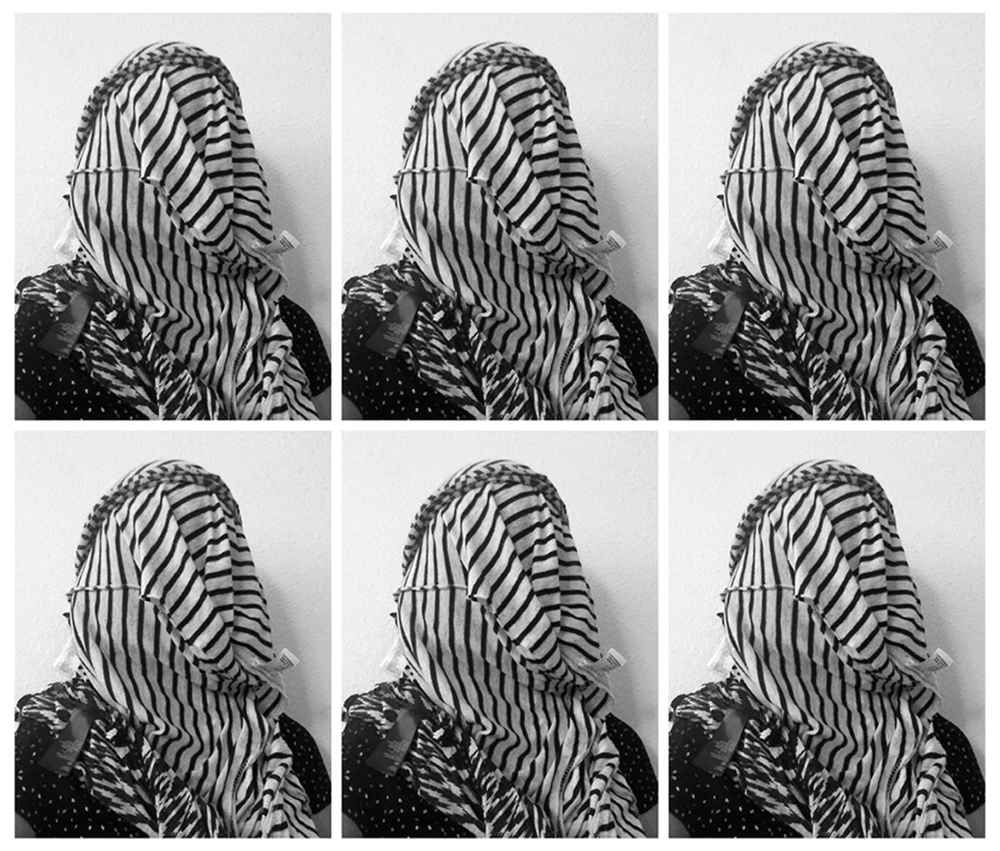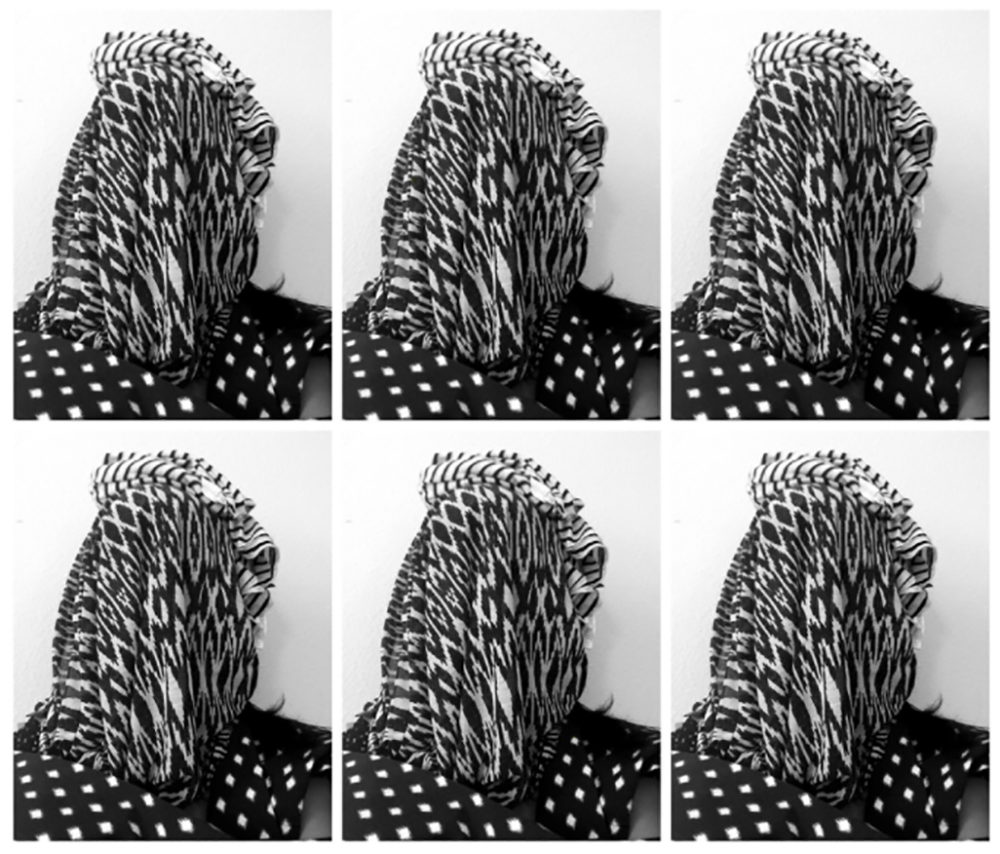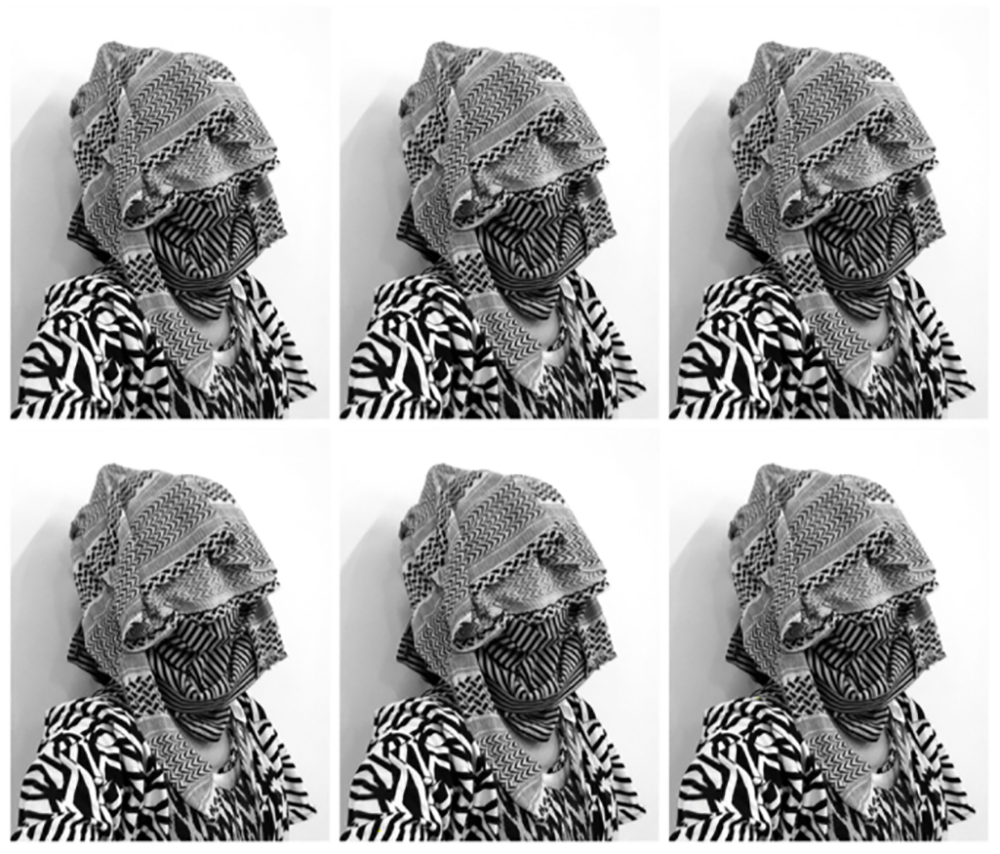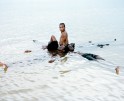Reframing the Passport Photo at the Wallach Gallery at Columbia University
 Tomoko Sawada. ID-400 #201-300, 1998. 100 Gelatin silver prints; Overall: 50 x 40 in. International Center of Photography, Purchase, with funds provided by the ICP Acquisitions Committee, 2005. ©Tomoko Sawada. Image courtesy of ROSEGALLERY.
Tomoko Sawada. ID-400 #201-300, 1998. 100 Gelatin silver prints; Overall: 50 x 40 in. International Center of Photography, Purchase, with funds provided by the ICP Acquisitions Committee, 2005. ©Tomoko Sawada. Image courtesy of ROSEGALLERY.
In our continuing efforts to feature exhibitions that have been impacted by Covid 19, we are sharing a terrific exhibition at the Wallach Gallery at Columbia University, Reframing the Passport Photo, curated by Hannah Morse. She shares her curatorial statement and a selection of the images today.
Hannah Morse is a Curatorial Fellow at the Wallach Gallery and a graduate student in Columbia University’s Modern and Contemporary Art: Critical and Curatorial Studies (MODA) program. She is particularly interested in photography and its dual function as both document and fine art. Hannah is drawn to works that blur distinctions between the two—passport photos, photo booth pictures, mug shots—and raise questions about the camera and the illusion of objectivity. She can be reached at hannah.morse@columbia.edu.
Reframing the Passport Photo uses the passport as a lens through which to view contemporary issues associated with the globalized world: migration, nationalism, access, belonging, and personhood. Showing four artists whose work references the passport photo—Martina Bacigalupo, Tomoko Sawada, Stephanie Syjuco, and Sheng Qi—the exhibition explores the premises that underlie modern identification practices, exposing the growing gaps between personal identity and state-sanctioned identification. Together, the works shed light on the assumptions embedded within the international passport system and the social stratifications they perpetuate.
The defining issues of the current historical moment center around rethinking the structure of the modern world and the people who inhabit it; the passport is a means by which international borders are enforced, and people are included or excluded. The proposed wall between the United States and Mexico, the Brexit movement, the Israeli/Palestinian divide, the tension between Hong Kong and mainland China, the Basque people’s desired split from Spain—these are just some of many recent world conflicts involving issues of identity, identification, borders, and belongingness.
Today, it is hard to believe that the passport system was formally written into international law only one hundred years ago, initially as a temporary postwar measure(1). Despite the original intention, the passport system was never revoked—a return to the “good old days when optional passports existed”(2) was deemed unlikely, due to the “demobilization, dislocation, unemployment, fears of Communist subversion, [and] monetary crises” prevalent in the aftermath of World War I.(3) While the rigidity of the passport system has fluctuated during the twentieth century, bending to make room for economic treaties and tourism, borders today are tight and highly secured, and the passport is an “indispensable feature of international travel.”(4) Presenting one’s identification documents has become so commonplace and matter-of-fact that the basis for these documents has been obscured.
In the case of the passport photo, it can be especially revealing to break down some of the assumptions that underpin its use—for example, that identity can be documented, that it can be captured in a single image, and that the set requirements of the passport photo are the best way to capture it. Beyond its discomforting formal components—an isolated and emotionless face gazing straight ahead, like its predecessor, the mug shot—what does the passport photo reveal?(5)
Martina Bacigalupo, Tomoko Sawada, Stephanie Syjuco, and Sheng Qi each question the centrality of the face to both personal identity and bureaucratic identification practices. The face functions doubly as a site for individual recognition, where memory and emotional expression are central, and collective registration, where race and sex (and the theories of physiognomy that underlie them) are primary concerns. Though technology has advanced beyond the capturing of a physical image, the human visage remains central to state-controlled passage across national borders. While fingerprinting and iris recognition technology allow for the efficient identification of unique individuals, photographs of faces allow for individuals to be stored and remembered. The power of the image of the face goes beyond the immediate need for identification, extending into the future need for recognition. By altering the face’s features, obscuring it, or removing it altogether, the artists exhibited in Reframing the Passport Photo consider the power of the face and the meaning attributed to it.
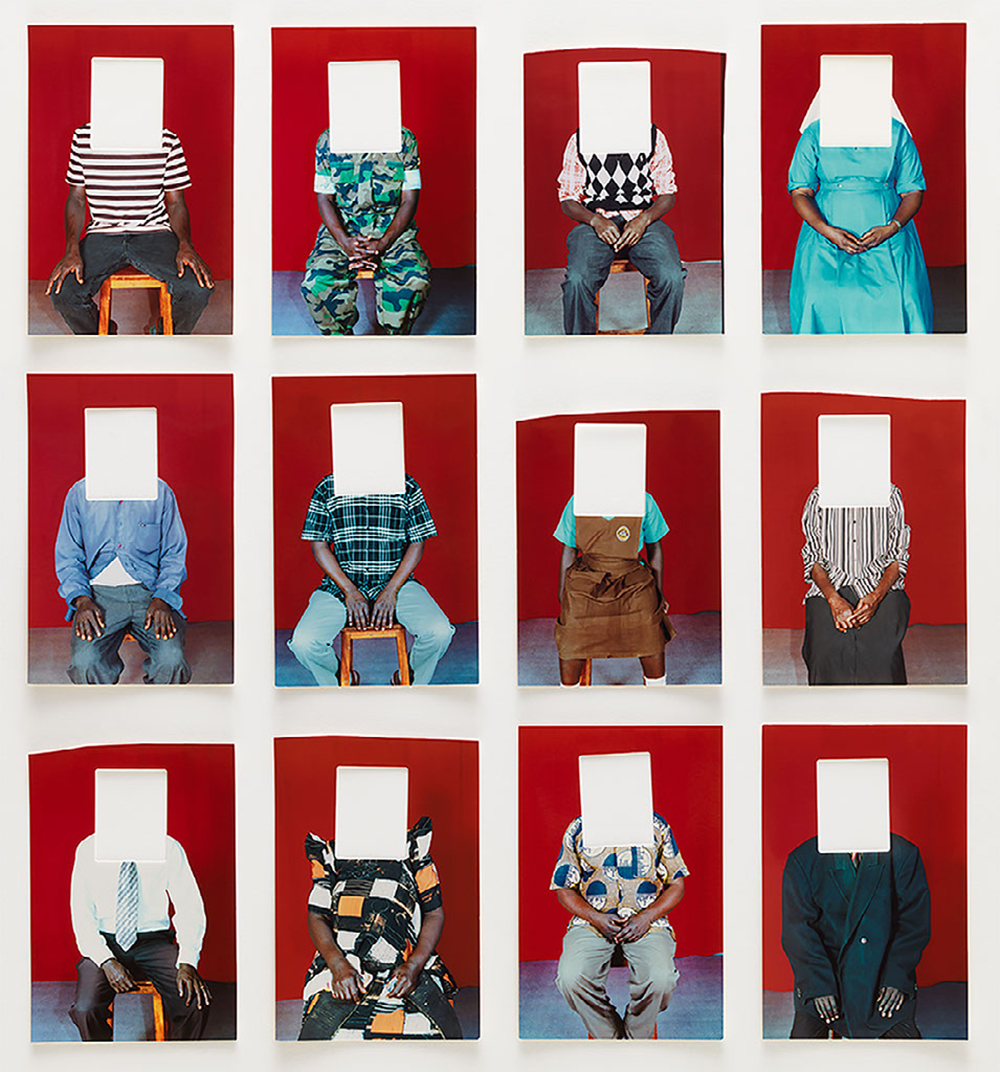 Fig. 1. Martina Bacigalupo. Selections from Gulu Real Art Studio XXXVI and XIX, 2011–2013. Twelve found c-prints; 5.9 x 3.9 in. ©Martina Bacigalupo. Courtesy the artist and Yossi Milo Gallery, New York.
Fig. 1. Martina Bacigalupo. Selections from Gulu Real Art Studio XXXVI and XIX, 2011–2013. Twelve found c-prints; 5.9 x 3.9 in. ©Martina Bacigalupo. Courtesy the artist and Yossi Milo Gallery, New York.
Martina Bacigalupo’s Gulu Real Art Studio (2011–2013, fig. 1) is made up of over one hundred found photographs, originally taken by Obal Denis at a photography studio in Gulu, Uganda. In each work, the subject’s face has been cut out and used for passport applications, as well as applications for scholarships, bank accounts, and loans from nongovernmental organizations.
It was too costly for many people to use the standard ID photo machine that produces four passport-size photos automatically, so Denis took full-body portraits, cut out the faces, and discarded the remaining portions. Bacigalupo discovered the discarded images in 2011 in the studio’s garbage, and she received Denis’s permission to sort through and select some. Offering a sense of growth, of change, and of hope, these works speak to the complexities of identification photography, finding a striking balance between the genre’s mixed messages of emancipation and constraint. Looking closely at the images that make up the Gulu Real Art Studio series, we become invested in the individuals represented. We are pushed beyond the question of identification and begin to wonder about these people’s pasts and futures. Where are they planning to go? Have they arrived yet?
With the heads neatly removed and sent on their way elsewhere, only the bodies of the applicants remain. The individuals in the photos, despite being faceless, communicate their individuality through hand gestures, clothing, and postures. The ways in which they hold themselves—some relaxed and others tense, some with hands clasped and others open, some with legs heavily rooted in the ground and others perched lightly—come to the forefront of the images. The patterned clothing and the particular way it clings to each person’s body take on meaning. The formal components of identification photos are here subverted; without faces, we still get a sense of who these people are. In Gulu Real Art Studio, personal identity is literally at odds with state-sanctioned identification—while the two overlap conceptually, here they are physically separate.
The idea that identity could be reliably translated into a document was not widely accepted until the 1930s, and it “required a rethinking of ideas of authenticity and the self, and the relationship of individual identity to the body, particularly how class, gender, and race were articulated to embody privilege.”(6) In ID-400 #201-300 (1998, fig. 2), Tomoko Sawada questions the relationship between our outer and inner selves, posing one hundred times in an instant photo machine, and altering her hair, accessories, expressions, clothing, and makeup each time. In performing many different identities for the camera, Sawada highlights the malleability of identity and calls into question concepts of selfhood and individuality—ideas that are central to identification photography and forms of state-sanctioned representation. Which photo depicts the “real” Tomoko Sawada?
 Fig. 2. Tomoko Sawada. ID-400 #201-300, 1998. 100 Gelatin silver prints; Overall: 50 x 40 in. International Center of Photography, Purchase, with funds provided by the ICP Acquisitions Committee, 2005. ©Tomoko Sawada. Image courtesy of ROSEGALLERY.
Fig. 2. Tomoko Sawada. ID-400 #201-300, 1998. 100 Gelatin silver prints; Overall: 50 x 40 in. International Center of Photography, Purchase, with funds provided by the ICP Acquisitions Committee, 2005. ©Tomoko Sawada. Image courtesy of ROSEGALLERY.
Even with the knowledge that each image is a photograph of the artist, it is hard to accept that each photo depicts the same person. Though not modeled upon specific individuals, Sawada’s personas read as distinct, real people. The small details and the decisions she makes produce a set of familiar characters—people from our lives whom we have classified and categorized in a way that parallels the government and its identification practices. Despite the widespread knowledge that a photograph is far from an impartial document, bureaucracies continue to rely on photography’s technical ability to capture physical likeness. Sawada shows us that photographs are not simply records of our physical likenesses (7)—we make judgments based upon them.
In the case of the passport photo, whose language Sawada borrows, the stakes are high. In discussing concepts of criminality, photographic portraiture, and the mug shot, Allan Sekula famously argues that photography does not simply document the criminal body, but that it produces certain “criminal types”: “Thus photography came to establish and delimit the terrain of the other, to define both the generalized look—the typology—and the contingent instance of deviance and social pathology.”(8) If the mug shot gave rise to the “criminal type” (ask yourself the question, What does a criminal look like?), what has the passport photo produced? The passport photo’s impact goes well beyond identification, shaping public perception of the “immigrant type.” Francis Galton’s photographic composite of The Jewish Type (1878, fig. 3) speaks to the reductive power of identification photography and its incalculable consequences.
 Fig. 3. Galton’s eugenics. Jewish portraits, 1878. PAUL D STEWART/SCIENCE PHOTO LIBRARY.
Fig. 3. Galton’s eugenics. Jewish portraits, 1878. PAUL D STEWART/SCIENCE PHOTO LIBRARY.
Sawada’s serial presentation of the images—one hundred photos, each printed four times, arranged in columns and rows of ten—renders the many characters anonymous. Although documenting identity is the highest priority of a passport image, this does not translate when the photos are shown in large numbers. Faces become lost in a sea of similar and dissimilar features; the focus shifts from who one is to what type of person one is. Sawada’s work gives rise to a more nuanced understanding of the relationship between hypervisibility and invisibility. In Sawada’s ID-400 #201-300, identity and anonymity exist alongside one another.
In Stephanie Syjuco’s Applicants (Migrants) series (2013–18, fig. 4), the artist obscures her face with “ethnic” patterned textiles that, in reality, come from American retail stores—in the images, clothing tags are comically visible. She poses several times and turns her body to face slightly left, slightly right, and fully forward, recalling the minor shifts in the passport photo’s strict guidelines that vary from one country to the next. While these images depict multiple “applicants” who sit for their passport photos hoping for permission to immigrate, Syjuco is the subject in each work. Of course, this cannot be discerned by looking at the photos themselves. Masking herself from view in each image, she begs the question, Can you see me?
Fig. 4. Stephanie Syjuco. Applicants (Migrants) #1, #2 and #3, 2013-2018. Archival pigment prints; each 3 x 4 1/2 in. ©Stephanie Syjuco. Courtesy the artist and RYAN LEE Gallery, New York.
Appropriating the formal components of the passport photo grid, Syjuco’s series speaks to the facelessness and de-individualizing nature of the immigration process, looking specifically at how cultural, national, and religious symbols prevent people from being seen as individuals. Syjuco relocates the site of identification practices from the physical passport photo to its viewer. Interpretation supersedes recognition—the physical features of the face, while a key aspect of identification practices, can be colored by preexisting biases, experiences, and values. Like in Sawada’s work, anonymity and identity coexist here, as do hypervisibility and invisibility. People who sit for their standardized identification photographs are not seen as unique individuals, but rather are grouped into pre-set categories.
In Memories (Me) and Memories (Mother) (2000, figs. 5–6), Sheng Qi also considers what it means to be visible but not seen. The works are a point of access into questions around the relationship between personal and social histories. Sheng photographs his disfigured hand holding passport-style photographs of himself and of his mother. Sheng amputated his own finger in protest after the 1989 Tiananmen Square massacre in Beijing. His childhood identification photo looks benign at first glance; so does the photo of his mother. However, with the images cupped in his particular hand, with its given history, Sheng exposes the complexities within the relationship between subject and state.
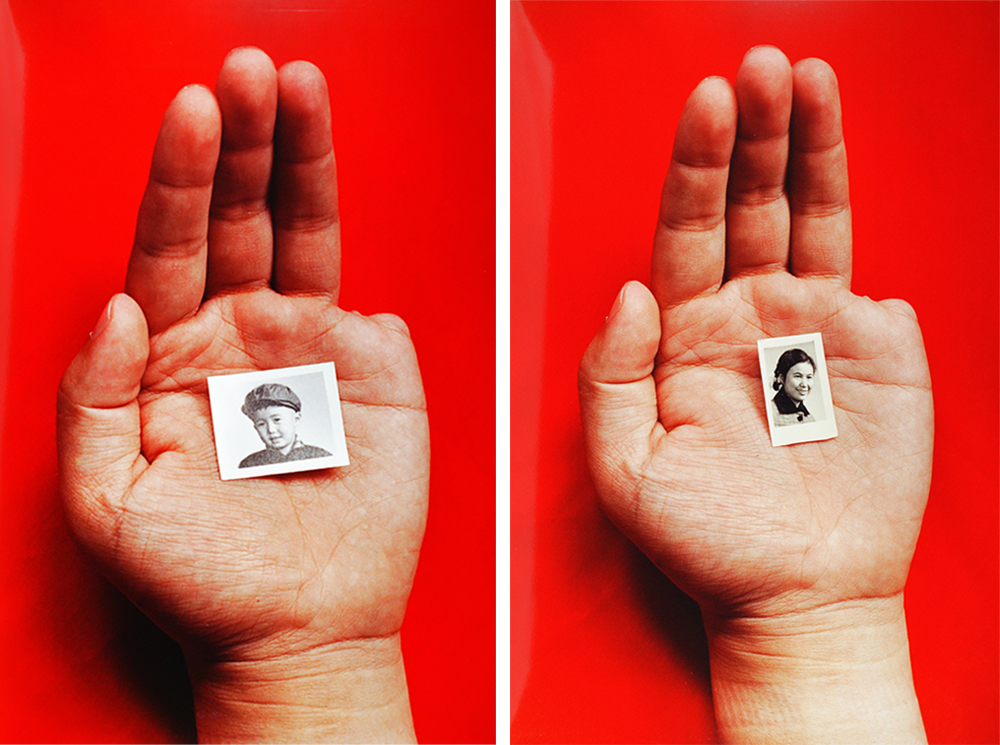 Sheng Qi. Memories (Me), 2000 (left) and Memories (Mother), 2000 (right). Chromogenic prints; each 33 1/4 x 31 3/4 in. International Center of Photography, purchase, with funds from Anne and Joel Ehrenkranz, 2004. ©Sheng Qi. Courtesy the artist and International Center of Photography.
Sheng Qi. Memories (Me), 2000 (left) and Memories (Mother), 2000 (right). Chromogenic prints; each 33 1/4 x 31 3/4 in. International Center of Photography, purchase, with funds from Anne and Joel Ehrenkranz, 2004. ©Sheng Qi. Courtesy the artist and International Center of Photography.
The absence of Sheng’s pinky finger and the presence of closely cropped faces in his palm draw attention to the strangeness of the identification photographs. The assumptions embedded within them become more visible, more peculiar. The identification photos of Sheng and his mother look so sterile surrounded by the crisscrossing lines in Sheng’s fleshy hand; linear marks on his wrist indicate he might have recently removed his too-tight watch. The pieces’ red backgrounds and poster sizes recall Chinese propaganda campaigns, which reference the Maoist period of Sheng’s youth as well as media tactics in China today.(9) The flesh of Sheng’s hand, shown in color, feels immediate, while the passport photos are confined to a time “before.” Of course, passport photos are always “before” pictures—taken before a move away from home or a visit somewhere. They are not equipped to represent the changes that travel elicits; there is no room for growth in state-sanctioned identification. For Sheng, his identity lies in absence—in the part of his body that is missing, shaped by the loss and betrayal of Chinese government action in Tiananmen Square. It is the same government that Sheng and his mother had smiled for, years prior. Through these stark contrasts of past and present, of presence and absence, of color and black and white, Sheng raises questions of authenticity and the value of truth.
Each of the artists presented in Reframing the Passport Photo explores the complexity of identity and the reductive nature of identification practices. Focusing on the documents that produce, regulate, and monitor international systems of movement and passage, the artists illuminate the effects that these documents have on both the individual and societal levels. What do we forfeit in the process of documenting identity? How do modern identification practices influence the way we make sense of ourselves? In The Passport in America: The History of a Document, Craig Robertson poses the fitting question, “How was it that a piece of paper . . . came to be accepted as a reliable answer to the question ‘Who are you?”’(10)
[1] Craig Robertson, The Passport in America: The History of a Document (New York: Oxford University Press, 2010), 218. Before this time, nations had their own individual requirements.
[2] League of Nations, Organization for Communication and Transit, Passport Conference Held at
Geneva from May 12th to 18th, 1926 (Geneva, Switzerland: The League of Nations, 1926), 42.
[3] Michael R. Marrus, The Unwanted: European Refugees in the Twentieth Century (New York: Oxford University Press, 1985), 93.
[4] Jesper Gulddal and Charlton Payne, “Passports: On the Politics and Cultural Impact of
Modern Movement Control,” Symploke 25, no. 1–2 (2017): 11.
[5] Tina M. Campt, Listening to Images (Durham, N.C., and London: Duke University Press,
2017), 30.
[6] Robertson, The Passport in America, 9.
[7] “The work that photographs do is no generic exception to the usually shady commerce between art and truth.” Susan Sontag, On Photography (New York: Farrar, Straus and Giroux, 1977), 6.
[8] Allan Sekula, “The Body and the Archive,” October 39 (Winter 1986): 7.
[9] In a 2012 interview, Sheng explains: “The red colour I use in the paintings signifies a warning. Chinese people are poor, they have a lack of social care, lack of education, [of] accommodation. The form of my painting is also like a poster . . . the poster is like propaganda . . . even now, it’s a propaganda country so my painting in a way is like . . .a propaganda presentation, so basically I use what they used and reflect that back.” Emily Jupp, “Sheng Qi: ‘Cutting Off My Finger Was My Proudest Moment,’” The Independent, December 3, 2012, https://www.independent.co.uk/arts-entertainment/art/features/sheng-qi-cutting-off-my-finger-was-my-proudest-moment-8375534.html.
[10] Robertson, The Passport in America, 219.
Posts on Lenscratch may not be reproduced without the permission of the Lenscratch staff and the photographer.
Recommended
-
Arnold Newman Prize: C. Rose Smith: Scenes of Self: Redressing PatriarchyNovember 24th, 2025
-
The Aline Smithson Next Generation Award: Emilene OrozcoNovember 21st, 2025
-
MATERNAL LEGACIES: OUR MOTHERS OURSELVES EXHIBITIONNovember 20th, 2025
-
Josh Aronson: Florida BoysNovember 1st, 2025
-
Robert Rauschenberg at Gemini G.E.LOctober 18th, 2025

